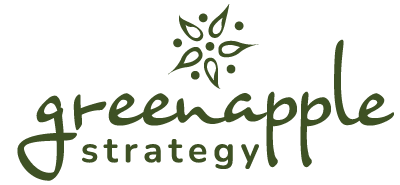When Green Apple launched back in 2012, content marketing was a buzzy new trend. The goal was simple: crank out content to generate leads. Fast forward to today, and the content marketing game has completely changed.
The challenge for many marketers, especially those on a small team, is figuring out if all that effort is actually worth it. Are you just writing into the void? Or is your content a valuable asset that’s making a real impact on your bottom line? You’re not alone if you’re asking these questions.
At Green Apple Strategy, we’ve been helping clients navigate these content challenges for years. We believe a strong content strategy can be one of your most powerful tools for bridging the gap between marketing and sales. A successful strategy starts by asking a few key questions to make sure your inbound marketing is actually worth the effort.
Here are five questions to help you tighten the link between content marketing and sales, along with some practical tips we’ve learned from working alongside our clients.
5 Questions to Evaluate and Enhance Your Content Marketing
1. What are the biggest gaps in your current sales and marketing process?
Everything you do with content should enhance your sales and marketing process. Are leads going cold after a meeting? Does your sales team need better resources to close deals? Taking time to identify these gaps will help you find ways to use content marketing to overcome them.
Ready to find your biggest gaps? Check out our free guide on how to identify and fix the broken parts of your sales funnel.
2. What questions do people have in different stages of the buying cycle?
The entire goal of content marketing is to address your prospective customers’ questions at the appropriate time. You must think through the journey a prospective customer takes from learning about your brand to becoming a loyal customer. What questions are they asking throughout that process? What problem are they trying to solve? Knowing the answer to these questions is essential. Your potential customers may be searching on Google, asking ChatGPT, or exploring social media to find these answers. The more often your content appears on different platforms, the better chance you have of connecting with your audience.
Once you know their questions, you need to meet them where they are. Learn how to connect with your audience through omni-channel communication.
3. What type of content can you create to answer those questions and give your prospects confidence in your company?
Knowing what questions your prospective customers are asking is only half the equation. Today, choosing the right format is an equally important part of getting the most out of your content. For example, new prospective buyers might be looking for helpful videos on social media or infographics. Prospective clients who are exploring your business might need a detailed case study or a product spec sheet to make a decision.
Creating the right content starts with knowing your customer. Our recent blog post can help you turn customer personas into impactful marketing strategies.
4. How can you help your sales team promote your content marketing resources?
Your content is a powerful tool for your sales team. By encouraging your team to use your content resources, you’re able to kill two birds with one stone. You can generate new leads and equip your sales team with resources to convert. It doesn’t have to be complicated. There are dozens of ways your sales and marketing teams can collaborate, like providing a list of resources in a shared document, creating email scripts with links to case studies, or sharing social media posts they can use.
Looking for a way to empower your sales team with better assets? Here are five effective ways to equip your sales team with content marketing.
5. How can you give people a reason to stay interested in your business, even if they’re not ready to buy?
Your content should always demonstrate an understanding of your audience’s needs and challenges. Don’t just think about what you want to tell prospects. Think about what they want to know. Your goal is to become a trusted voice that they turn to for information, not just another brand trying to sell them something.
One of the best ways to stay top of mind is with a newsletter. Check out our recent article on how to start (and scale) a newsletter to keep your prospects warm.
Work Smarter, Not Harder: How to Maximize Your Content Marketing
We know what it’s like to be a marketing team that’s under a lot of pressure. You’re juggling a dozen different tasks, and the idea of adding more to your plate can feel overwhelming. At Green Apple, we believe the key to success for smaller teams isn’t necessarily about working harder—it’s about working smarter.
Here are some of the ways we help our clients maximize their efforts and drive better results, even if they’re a small team or working with constrained budgets:
- Repurpose Your Content: You don’t have to reinvent the wheel every time. We help clients get the most out of their content by thinking more strategically. You can extract short video clips for social media, create an infographic with key stats, or pull compelling quotes for email marketing. This helps you get more out of every piece of content you create without a ton of extra work.
- Focus on Quality Over Quantity: You don’t have to post every day to be effective. It’s better to produce one high-quality, in-depth resource a month than to post low-quality content daily. Quality builds authority and trust with your audience. We work with our clients to identify their most valuable content needs and focus their energy there.
- Leverage AI Strategically: AI is a powerful tool, not a replacement for human creativity. We help our clients use AI tools to brainstorm ideas, summarize research, or draft outlines. This saves time and resources. But we never skip the human touch. The best content still comes from people who understand your brand’s unique voice and your audience’s needs.
- Maximize the Power of Visual Content: In 2025, creating content that catches your audience’s attention requires a combination of strategy, creativity, and adaptability. We help clients think through how to create visuals that stand out. This includes everything from custom photography and video to engaging infographics and social-first graphics.
- Write for the Future of Content: The rules of content are changing. Today, we write not only for people but also for the future of search, including Large Language Models (LLMs) and other AI tools. We work with clients to structure their content for clarity and authority, ensuring their valuable insights are discoverable and cited by AI-powered search engines.
Ready to Align Your Content Marketing with Your Overall Business Goals?
At Green Apple Strategy, we help companies create marketing strategies that actually support their larger business objectives, not just fill a calendar. Whether you’re looking to stand out in a competitive industry or build out sales resources and toolkits, we specialize in finding the best way to make sure your marketing efforts resonate with your audience and align with your business objectives.
Learn more about our strategic planning services or start a conversation with our team.










